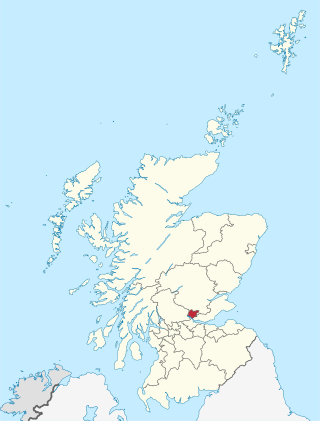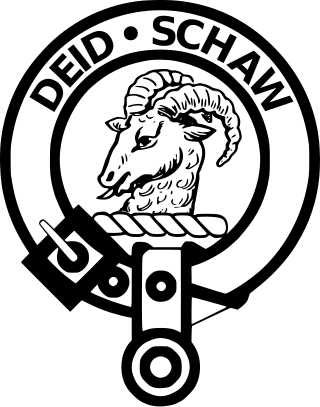
Clackmannanshire, or the County of Clackmannan, is a historic county, council area, registration county and lieutenancy area in Scotland, bordering the council areas of Stirling, Fife, and Perth and Kinross. In terms of historic counties it borders Perthshire, Stirlingshire and Fife.

Robert II was King of Scots from 1371 to his death in 1390. The son of Walter Stewart, 6th High Steward of Scotland, and Marjorie, daughter of King Robert the Bruce, he was the first monarch of the House of Stewart. Upon the death of his uncle David II, Robert succeeded to the throne.

The House of Stuart, originally spelled Stewart, was a royal house of Scotland, England, Ireland and later Great Britain. The family name comes from the office of High Steward of Scotland, which had been held by the family progenitor Walter fitz Alan. The name Stewart and variations had become established as a family name by the time of his grandson Walter Stewart. The first monarch of the Stewart line was Robert II, whose male-line descendants were kings and queens in Scotland from 1371, and of England, Ireland and Great Britain from 1603, until 1714. Mary, Queen of Scots, was brought up in France where she adopted the French spelling of the name Stuart.

The title Earl of Moray, or Mormaer of Moray, was originally held by the rulers of the Province of Moray, which existed from the 10th century with varying degrees of independence from the Kingdom of Alba to the south. Until 1130 the status of Moray's rulers was ambiguous and they were described in some sources as "mormaers", in others as "Kings of Moray", and in others as "Kings of Alba". The position was suppressed by David I of Scotland some time after his defeat of Óengus of Moray at the Battle of Stracathro in 1130, but was recreated as a feudal earldom by Robert the Bruce and granted to Thomas Randolph, 1st Earl of Moray in 1312.

Earl of Elgin is a title in the Peerage of Scotland, created in 1633 for Thomas Bruce, 3rd Lord Kinloss. He was later created Baron Bruce, of Whorlton in the County of York, in the Peerage of England on 30 July 1641. The Earl of Elgin is the hereditary Clan Chief of Clan Bruce.

Earl of Carrick is the title applied to the ruler of Carrick, subsequently part of the Peerage of Scotland. The position came to be strongly associated with the Scottish crown when Robert the Bruce, who had inherited it from his maternal kin, became King of Scots in the early 14th century. Since the 15th century, the title of Earl of Carrick has automatically been held by the heir apparent to the throne, thus the current holder of the title is Prince William, Duke of Rothesay.

The Mormaer or Earl of Atholl was the title of the holder of a medieval comital lordship straddling the highland province of Atholl, now in northern Perthshire. Atholl is a special Mormaerdom, because a King of Atholl is reported from the Pictish period. The only other two Pictish kingdoms to be known from contemporary sources are Fortriu and Circinn. Indeed, the early 13th century document known to modern scholars as the de Situ Albanie repeats the claim that Atholl was an ancient Pictish kingdom. In the 11th century, the famous Crínán of Dunkeld may have performed the role of Mormaer.
When the crown of Scotland became vacant in September 1290 on the death of the seven-year-old Queen Margaret, 13 claimants to the throne came forward. Those with the most credible claims were John Balliol; Robert de Brus, 5th Lord of Annandale; John Hastings, 1st Baron Hastings; and Floris V, Count of Holland.

Marjorie Bruce or Marjorie de Brus was the eldest daughter of Robert the Bruce, King of Scots, and the only child born of his first marriage with Isabella of Mar.
Marjorie of Carrick was Countess of Carrick, Scotland, from 1256 to 1292, and is notable as the mother of Robert the Bruce.

The Clan Ruthven is a Lowland Scottish clan.

Robert V de Brus, 5th Lord of Annandale, was a feudal lord, justice and constable of Scotland and England, a regent of Scotland, and a competitor for the Scottish throne in 1290/92 in the Great Cause. He is commonly known as "Robert the Competitor". His grandson Robert the Bruce eventually became King of Scots.

Clan Bruce is a Lowlands Scottish clan. It was a royal house in the 14th century, producing two kings of Scotland, and a disputed High King of Ireland, Edward Bruce.

Clan Moncreiffe is a Highland Scottish clan.

Clan Oliphant is a Highland Scottish clan.
Sir Robert Bruce, Lord of Liddesdale was the illegitimate son of King Robert the Bruce and an unknown mother. He was knighted and awarded the royal arms at the Battle of Bannockburn in 1314. The youngest a man could be knighted was 21, meaning 1293 is the latest he could have been born.
Sir Robert Bruce, 3rd Baron of Clackmannan & Rate was the son of Sir Robert Bruce, 2nd Baron of Clackmannan & Rate and Isabel Stewart of Fife.
Sir Robert Bruce, 2nd Baron of Clackmannan & Rate was the son of Sir Thomas Bruce 1st Baron of Clackmannan and Marjorie Charteris of Stenhouse.

The Clackmannan Tower is a historic five-storey tower house situated at the summit of King's Seat Hill in Clackmannan, Clackmannanshire, Scotland. It dates back to at least the 14th century when it was inhabited by King David II of Scotland and later sold to his cousin Robert Bruce, 2nd Baron of Clackmannan in 1359.
Alexander de Abernethy was a Scottish baron. He was a son of Hugh de Abernethy and Maria de Ergadia. Alexander was a descendant of abbots of Abernethy; his great-grandfather Laurence, great-grandson of Gillemichael, Earl of Fife, was the first to style himself Lord (dominus) His daughter Margaret married John Stewart of Bonkyll, the new Scottish earl of Angus.